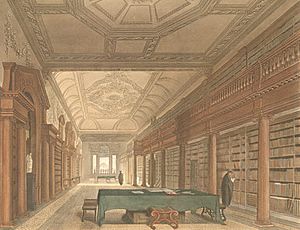John Phillips (c. 1709–1775) facts for kids
John Phillips (born around 1709, died December 28, 1775) was a very skilled English builder and architect. He was known for his work in London during the 1700s. He was a master carpenter, which means he was excellent at working with wood to build things.
Contents
A Family Business
John Phillips took over a big building business from his uncle, Thomas Phillips. His uncle was also a talented builder who worked on many projects. Thomas Phillips built houses to sell on the Harley estate. He also did all the carpentry work for famous buildings like St Martin-in-the-Fields church. His uncle even built a wooden bridge across the River Thames between Fulham and Putney in the 1720s.
Building London's West End
John Phillips often worked with a partner named George Shakespear. Together, they helped develop many parts of London's West End. For example, they built houses on Charles Street in Mayfair around 1750. Phillips was also in charge of building a large section of the Grosvenor estate.
They built some grand houses for important people. One was for Lord Bateman (1759–60) at the top of Park Lane. Right next to it, they built Camelford House (1773–74) for Thomas Pitt.
Projects in Oxford
Phillips also worked on important buildings outside London. In Oxford, he built the wooden dome for the Radcliffe Camera. This building is famous for its round shape and library. He also created beautiful wooden interiors for it between 1742 and 1750.
Phillips and Shakespear also designed the wooden interiors for the Christ Church Library in Oxford. They worked on this project from 1752 to 1762.
Country Estates and Bridges
John Phillips and George Shakespear also worked on country estates. They added new parts to Alscot Park in Warwickshire between 1750 and 1752. Later, they rebuilt a section of the house in a Gothick style. This style looked like old medieval castles. They also took down parts of Audley End for Elizabeth, Countess of Portsmouth.
In 1771–72, Phillips built another wooden bridge. This one was at Battersea and was designed by the architect Henry Holland. However, this bridge was taken down in 1881.
Royal Carpenter and Legacy
During his career, John Phillips held an important job. He was the Carpenter to His Majesty's Board of Works. This meant he was the main carpenter for royal building projects.
Phillips lived in a house on Brook Street that he inherited from his uncle. This house still stands today at 39 Lower Brook Street. When he retired, he built and lived in Culham House in Culham, Oxfordshire. Even though John Phillips did not have children, his brother's family continued to live there until 1935.
A special stone monument, called a sarcophagus, was made to remember John Phillips. You can find it in the parish church of East Hagbourne.


